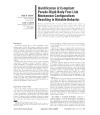
In a similar way, simple examples facilitate understanding, followed by more complicated examples that demonstrate how the material can be used in applications. This is done by organizing the chapters into major sections of introduction, fundamentals, analysis, design, and special-purpose mechanisms. The chapters are organized to flow from simple to more complex concepts the book then concludes with the application of the previous materials to specific types of devices. The advantages of compliant mechanisms in the emerging area of microelectromechanical systems (MEMS) are also addressed, and several MEMS examples are provided throughout the book.
%2C445%2C291%2C400%2C400%2Carial%2C12%2C4%2C0%2C0%2C5_SCLZZZZZZZ_.jpg)
This simplification makes it possible to design compliant mechanisms for many types of tasks. The pseudo-rigid-body model is introduced as a method which simplifies the analysis of compliant mechanisms that undergo large deflections by modeling them with elements common to traditional mechanisms. The analysis of small deflection devices is addressed, but emphasis is given to compliant mechanisms that undergo large, nonlinear deflections. The materials in the book provide ideas for engineers to employ the advantages of compliant mechanisms in ways that otherwise may not be possible. The book presents methods for the analysis and design of compliant mechanisms and illustrates them with examples.

The purpose of this book is to fulfill this need for students, practicing engineers, and researchers. Since much research in the theory of compliant mechanisms has been done in the last few years, it is important that the abundant information be presented to the engineering community in a concise, understandable, and useful form.

Compliant mechanisms offer great promise in providing new and better solutions to many mechanical-design problems.


 0 kommentar(er)
0 kommentar(er)
